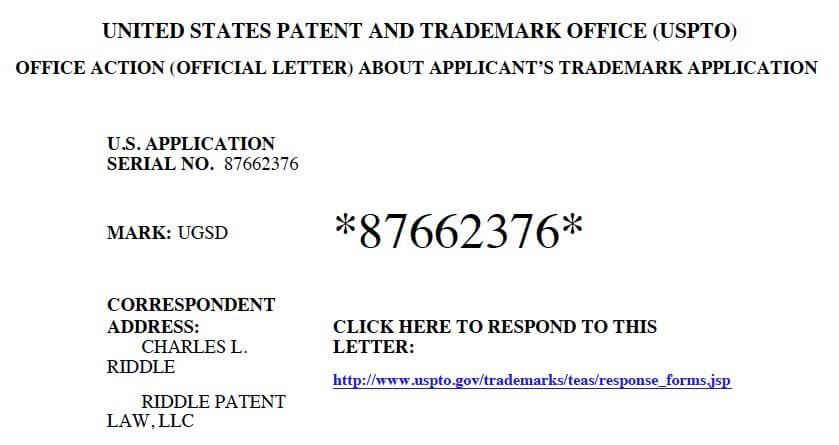How to Respond to Trademark Office Action – Prior-Filed Application Rejection

A Prior-Filed Application notice means that another pending trademark application is blocking yours. Someone else filed an application before your application date, and the earlier application is similar enough to yours to be a grounds for rejection.
Trademark Office Action – Prior-Filed Application Rejection
The typical Prior-Filed Application rejection language reads:
A prior-filed pending application may present a bar to registration of applicant’s mark.
The filing date of pending U.S. Application Serial No. 87524922 precedes applicant’s filing date. See attached referenced application. If the mark in the referenced application registers, applicant’s mark may be refused registration under Trademark Act Section 2(d) because of a likelihood of confusion between the two marks. See 15 U.S.C. §1052(d); 37 C.F.R. §2.83; TMEP §§1208 et seq. Therefore, upon receipt of applicant’s response to this Office action, action on this application may be suspended pending final disposition of the earlier-filed referenced application.
In response to this Office action, applicant may present arguments in support of registration by addressing the issue of the potential conflict between applicant’s mark and the mark in the referenced application. Applicant’s election not to submit arguments at this time in no way limits applicant’s right to address this issue later if a refusal under Section 2(d) issues.
What Does a Notice of Prior-Filed Application Mean?
Simply put, a Prior-Filed Application notice means that another pending trademark application is blocking yours. Someone else filed an application before your application date, and the earlier application is similar enough to yours to be a grounds for rejection. In this article, I refer to “Prior-Filed Application” and “blocking application” interchangeably, because that’s what it is.
But the Rejection Isn’t Final Until the Prior Application Registers
Prior-filed applications don’t always become trademark registrations. If the blocking application is denied, opposed, or abandoned, the prior-filed application rejection must be lifted. A prior-filed application must register as trademark to be grounds for a valid rejection. The prior filed (blocking) application may not register for various reasons. Some examples include express abandonment by the applicant, involuntary abandonment for not responding to office actions, and a final rejection for various grounds. The blocking application may get opposed by a third party in a Trademark Trial and Appeal Board (TTAB) opposition proceeding.
How to Respond to an Office Action With a Prior Filed Application Notice?
Step 1. Research the Pending Prior-Filed Application.
Determine the status of the Prior-Filed Application. In some instances, the application may be rejected, abandoned, or on its way to abandonment. Abandoned applications can’t be grounds for a prior-filed rejection – only trademark registrations. Look-up the Application File for the blocking application(s) cited in the Office Action. To search for a trademark application’s file, use the Application Number to search the USPTO’s Trademark Electronic Search System (TESS). After searching for the application by serial number, at the bottom of page there is a “Live/Dead Indicator“. If the Indicator states DEAD, your research work is over. It’s your (the applicant’s) job now to tell the examiner that the blocking application is now abandoned – clearing the path to registration. You response to your office action and state something like:
“The Office Action cites prior-filed application No. XX/XXX,XXX as grounds for a potential rejection. Applicant respectfully requests withdrawal of the rejection. The cited application is now listed as DEAD with TESS.”
It’s not always that easy as examining the Live/Dead Indicator. Most of the time, the research goes deeper and involves examining the file history of the blocking applications(s). The application file history can be found by looking in the Trademark Status & Document Retrieval (TSDR). Look for the buttons TSDR, STATUS, OR DOCUMENTS. Once you find the application file, look along the list of documents that make up the Application’s file and determine what stage or how close an application is or is not to registration. For example, a Prior-Filed pending Application may also have an office action. If the office action is not responded to in time, the blocking application will go abandoned. Remember, abandoned applications can’t be grounds for a prior-filed rejection – only trademark registrations.
And … the research goes even deeper. Next, look for Trademark Trial and Appeal Board (TTAB) Opposition Proceedings filed against the Prior-Filed Application. The blocking application could be subject to an opposition proceeding. If so, the prior-filed application could go abandoned as a result of the opposition. From TESS, look for a button labeled TTAB Status. From TSDR, look for a tab labeled “Proceedings – Click to Load.” An opposition proceeding could take years, leaving you in limbo waiting to see if the blocking application gets registered.
You only have six (6) months to respond to the office action. It could take years to determine whether the Prior-Filed application will register and become a block your application – or go abandoned. What do you do? This leads to the Steps Below – Suspend Your Application and/or Argue the Differences.
Step 2. Ask the Examining Attorney to Suspend the Application Until Final Outcome of Prior-Filed Application
It is often difficult to persuade the Examining Attorney to change her/his position on the 2(d) rejection. It’s best to save those arguments until the rejection becomes a reality – when the blocking application registers. Ask the Examining Attorney to Suspend the Application Until Final Outcome of Prior-Filed Application.
Applicant respectfully requests the Examining Attorney to suspend the present application pending the registration, amendment, or abandonment of the cited prior-filed application(s).
If you are highly confident you can overcome the 2(d) / likelihood of confusion rejection of the blocking application, Typically, requesting a suspension is the best option. There is always the option to argue for reconsideration of the priority rejection, but, in most cases, it is preferable to request suspension of the Office Action pending the outcome of the prior filed (blocking) application. Even if one believes he or she has persuasive arguments to dispute a 2(d) rejection, he or she can reserve his or her arguments until more is determined about the Prior Filed Application at issue. For instance, if the Prior Filed Application does not register, one effectively save time arguing something that ultimate became a nonissue. Furthermore, by withholding one’s arguments, the arguments do not become a part of the application file / public record. Sometimes information in the public record may become problematic if future disputes or litigation about your application or mark. In the event the other Prior Filed Application registers not arguing the matter before the PFA registered does not disadvantage an applicant. One may make such arguments after one’s application actually receives a 2(d) rejection.
Step 3. Argue the Differences in Sight, Sound, Meaning and Differences in Goods / Services
If you are confident you can overcome the 2(d) / likelihood of confusion rejection, make your best arguments that the cited prior-filed application(s) should be withdrawn. It is good practice to look up each prior filed application to identify the differences in the marks and the goods/services. Perhaps a narrowing amendment to the goods /services listed in your application will convince the Examining Attorney to withdraw the cited application(s). Perhaps you have obtained a letter of consent from the owner of the prior-filed application. If you do argue the rejection, it’s good practice to ask for a suspension of the case in the alternative.
In the instance that the Examining Attorney finds Applicant’s arguments unpersuasive, Applicant respectfully requests the Examining Attorney to suspend the present application pending the registration, amendment, or abandonment of the cited prior-filed application(s).
You can argue the differences immediately after receiving the office action. In most cases, however, it is preferable suspend the case and argue the rejection later, if needed, after the suspension is lifted. Your argument is wasted energy if the blocking application goes abandoned. In many instances , the Examining Attorney has made up her mind, and your argument alone won’t change things anyway.
Disclaimer: This information is for educational purposes, and is not intended to be legal advice. Each case turns on its own facts. Please consult with an experienced trademark attorney.
EsquireTrademarks.com – Online Trademark Attorneys – What We Do:
- Our trademark attorney, prepares and files trademark applications for clients throughout the United States and abroad.
- We prosecute and defend trademark infringement and unfair competition actions in the Federal Courts throughout the United States and abroad.
- We also prosecute trademark office actions and appeals before the United States Trademark Office.
- We handle internet based trademark disputes and trademark, DMCA, and copyright takedowns.
- We draw on our experience as trademark litigators to guide you through the trademark process.
- We support businesses, law firms, and individuals by providing top notch legal services in intellectual property matters.
